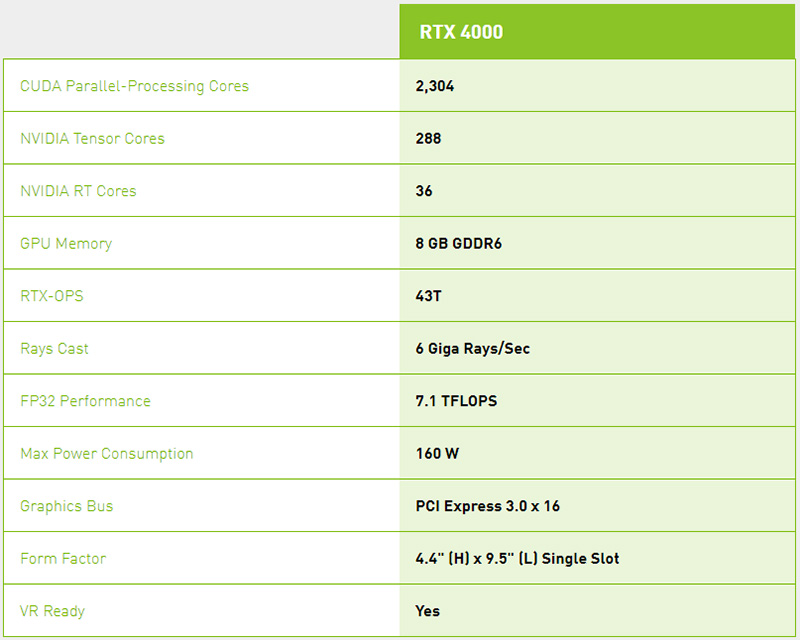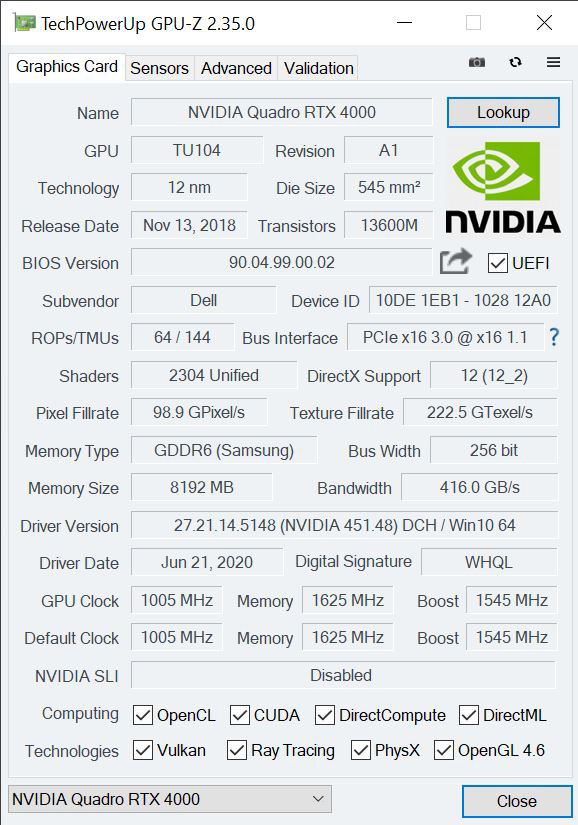NVIDIA Quadro RTX 4000 Specifications
Here are the key specs for the Quadro RTX 4000:

Two standouts that we wanted to point to here is the 160W power consumption figure. This helps increase density allowing for a single slot cooler design.
Testing the NVIDIA Quadro RTX 4000
Here is our test configuration:
- Motherboard: ASUS ROG Zenith II Extreme Motherboard
- CPU: AMD Threadripper 3960X (24 cores / 48 Threads)
- GPU: NVIDIA Quadro RTX 4000
- Cooling: NZXT Kraken X62
- RAM: 4x Corsair Dominator Platinum RGB 3600 MHz 16GB (64GB Total)
- SSD: Sabrent Rocket 4.0 NVMe PCIe Gen4 x4 M.2 SSD
- PSU: EVGA Supernova 1600 T2
- OS: Windows 10 Pro
Here is the obligatory GPU-Z shot of the Quadro RTX 4000:

GPU-Z shows the primary stats of our testing the Quadro RTX 4000. The GPU clocks in at 1,005 MHz and can boost up to 1,545 MHz. Pixel Fillrates run at 98.9 GPixels/s, and Texture Fillrate comes in at 222.5 GTexel/s, while memory runs at 1,625 MHz. Again, we see 8GB of memory on the Quadro RTX 4000.
Let us move on and start our testing with computing-related benchmarks.




The Quadro RTX 4000 has served me well at work in an external Thunderbolt GPU chassis as a portable production GPU. It is an interesting use case as the raw GPU performance was not as critical as getting several check boxes marked on the feature set which precluded many of the lower end Quadros and made anything higher end pure overkill.
One of the requisite features was support for the Quadro Sync II board so that it can be gen-locked with various video production equipment. Since the Quadro RTX 4000 is a single slot board, the Quadro Sync II card fit in with the external GPU chassis. Note that the gen lock board can mount into a PCIe slot, all communication with the GPU card is done via ribbon cables. In a small tower system, I’ve rigged up the same genlock board inside a front panel bay to save on slot spacing.
One of the more interesting things I’ve recently tested has been with nVidia voice where this graphics card get pulled in to do some audio processing in recent months.
The one thing on my wish list for any future nVidia A4000 replacement card would be include Thunderbolt 4 ports on the GPU itself instead of Virtual-Link. It’d be far more useful and there are a handful of video production boxes with Thunderbolt 3 interfaces that could hypothetically communicate directly with the A4000’s hardware video encoders, reducing latency for real time encoding by a few critical hairs. Similarly, an HDMI 2.1 port would be valuable for the video production area that I’ve been involved in lately as a DisplayPort to HDMI adapter would not be necessary for display. Though for a multidisplay system where timing is critical, having all the ports leveraging the same adapters does equalize time vs. one native HDMI port and multiple DP ports with active adapters.
I have installed the NVIDIA RTX 4000 on my Intel s2600stbr motherboard with 256GB ram and two 10 core intel Xeon silver 4210 CPUs with windows 10 pro for workstations, and got the message after compatibility check that due to programs running in the background or OS incompatible, can anyone help with this.
I have an RTX 4000 in my Dell Precision T7610 with two 10 core Xeons and 128gb RAM. Very strangely the machine totally refused to boot up with the RTX card in the PCI-E 16x slot that in intended for the GPU card, so I removed it and put it in the lower PCI-E 16x slot and it’s fine. Bit weird but there we go.
It runs hot. Even with the case fans running fairly energetically it was in the 80’s on full load. I’ve put a slot-fan both above and below the card forcing more air to blow all over it and it’s shaved about 10 degrees off, much better. But now I’m using three slots for a single slot card, which defeats the object somewhat!
Lovely card though.